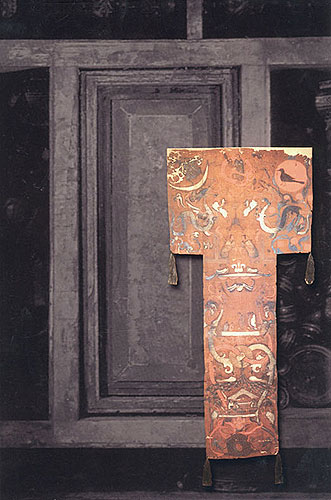| Art Q&A > Archeology |
|
|
Tombs of Han at Mawangdui
Tombs of a man named Li Cang and his wife and son, who lived in the State of Changsha, Western Han Dynasty (206BC-8AD)
Location: Changsha, Hunan Province
Period: earlier period of 2nd century BC
Excavated from 1972 to 1974
Significance: It has offered important materials for the study of the burial systems, the developments of handicraft and technology in the early Han Dynasty, as well as the history, culture and social life of the State of Changsha.
Located in the eastern suburbs of Chansha,
Hunan Province, the Mawangdui Han Dynasty Tombs were uncovered in 1972. The
three tombs, which date back some 2,100 years to the Western Han Dynasty
(206BC-25AD), contained the remains of the Marquis Dai, his wife and son, and
their most prized possessions.
Among the more than 3,000 relics unearthed, were exquisite lacquer-ware, musical instruments, silk paintings, bamboo slips, seals, pottery and Chinese medicinal herbs, etc. Of all the remains, the most astonishing was the corpse of Marquise Xin Zhui, the wife of the Marquis of Dai, which was extremely well preserved and in remarkable condition, from skin to inner organs. Most of the artifacts including the corpses can now be found in Hunan Provincial Museum.
Some 2,100 years ago, Xin Zhui enjoyed every luxury that the Han Dynasty had to offer. Xin Zhui lived her life surrounded by lacquer boxes, ornate pottery, musical instruments and an astonishing array of fine textiles. Her tomb, discovered in 1971 in the Changsha suburb of Mawangdui, proved to be a fantastic reliquary of the Western Han artifacts.
Buried with Xin Zhui were all the elegant trappings of her noble existence, perfectly preserved in a timber-lined tomb the size of a swimming pool. All these riches were buried with Xin Zhui to make her stay in the afterlife a more pleasant one. But more astonishing still was the body of the Marquise herself, which was found fully preserved and in remarkable condition, from skin to inner organs.
She may not have had a terra cotta army to escort her into the afterlife, but Xin Zhui certainly would have been well attended once there: Carved wooden figurines, painted and clothed in silk garments, include butlers, handmaidens, and an entire troupe of musicians to keep Xin Zhui entertained. A regiment of wooden soldiers stands on guard to protect her possessions. Actual musical instruments were included as well: A set of twelve pitch pipes to tune Heaven's chamber ensemble, bamboo flutes of various sizes, a 32-pipe mouth organ, and most impressive, a large 25-stringed Zheng, or zither. |
||||
All rights reserved. Reproduction of text for non-commercial purposes is permitted provided that both the source and author are acknowledged and a notifying email is sent to us. |
||||
 |
 Introduction
Introduction
 Cultural Heritage
Cultural Heritage